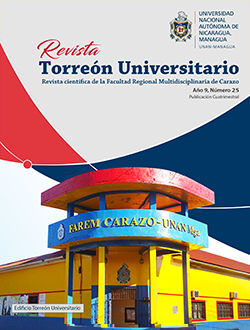Cabello humano para valorar la exposición a arsénico en usuarios de agua contaminada de la comunidad La Fuente en, La Paz Centro, León.
DOI:
https://doi.org/10.5377/torreon.v9i25.9856Palabras clave:
hidroarsenicismo, biomarcador, bioacumulación, termalismo, Volcán MomotomboResumen
La presencia de Arsénico en las aguas superficiales y subterráneas de Nicaragua está relacionada con los geoambientes presentes en el país. El área de estudio se encuentra al NE del volcán Momotombo, localizado en el arco volcánico de la Depresión Nicaragüense, donde el material geológico predominante son rocas y sedimentos del Cuaternario aluvial y volcánico. La comunidad de La Fuente está conformada por 112 familias (1300 habitantes) que se abastecen de agua en su mayoría por fuentes artesanales (90 pozos excavados, y tres perforados, uno de ellos es comunitario). En un estudio previo se determinó Arsénico total en agua en un rango de 2.0 a 103.0 µg/L, reportándose el máximo valor en un manantial termal; en donde un 70% de los sitios monitoreados (24 pozos) presentan valores no aptos para consumo (mayor o igual a 10 µg/L). El Arsénico presente en el agua es absorbido por los tejidos, para posteriormente ser eliminado en la orina; pero cuando la ingesta es mayor que la excreción éste tiende a acumularse en cabello y uñas, al igual que en la orina y la sangre; siendo estos excelentes biomarcadores de exposición aguda y crónica a este metaloide. Considerando el tiempo de ingesta de agua contaminada con arsénico por pobladores de La Fuente, se decidió determinar si hay presencia de arsénico en los pobladores de La Fuente, utilizando el cabello humano como indicador biológico. Se identificó un grupo focal para este estudio considerando las mayores concentraciones de arsénico presentes en agua, así como también el mayor tiempo de ingesta, resultando un grupo poblacional de 43 mujeres y 9 varones. Se colectaron aproximadamente 5 gramos de cabello de cada individuo a ser evaluado, totalizando 52 muestras de cabello. Las concentraciones de arsénico detectadas en cabello oscilaron entre 0,014 y 0,925 µg·g-1; siendo menores a 1,00 µg·g-1, valor establecido como criterio de toxicidad por el Centro Toxicológico de Quebec (CTQ). Las mayores concentraciones de arsénico están asociadas a la persona de mayor edad (mujer de 90 años) probablemente debido al mayor tiempo de exposición; y a la de menor edad (niño de 7 años) probablemente este contaminante se transmite de madre a hijos a través del cordón umbilical, presentando el neonato una concentración similar a su madre al momento de nacer. Los comunitarios fueron informados de sus resultados como parte del compromiso social con la población sujeta al estudio.
Descargas
Descargas
Publicado
Cómo citar
Número
Sección
Licencia
Los autores que publican en esta revista están de acuerdo con los siguientes términos.
- El autor o los autores de los artículos, ensayos o investigaciones conceden a la Universidad Nacional Autónoma de Nicaragua, Managua (UNAN-Managua) los derechos de edición (copyright) del trabajo enviado, por consiguiente la Universidad cuenta con el derecho exclusivo para publicar el artículo durante el periodo completo de los derechos de autor.
- Estos derechos de autor/ autores autorizan a la Revista Torreón Universitario y a la Universidad editar y divulgar/publicar el artículo en dicha Revista, incluyendo reproducción impresa y electrónica, el almacenamiento, recuperación y cualquier otro tipo de publicación, y fuentes de información secundaria como servicios de resúmenes y bases de datos, así mismo la facultan a proteger el artículo contra el uso no autorizado para su difusión por medios impresos o electrónicos (PDF, HTML, EPUB, XML u otros).
Licencia para el uso del contenido
La revista hace uso de la Licencia Creative Commons Atribución-NoComercial-SinDerivar 4.0 Internacional.
Bajo esta declaración:

Este revista está sujeta a una licencia de Creative Commons Reconocimiento-NoComercial-SinObraDerivada 4.0 Internacional. Puede ser copiada, distribuida y transmitida públicamente siempre y cuando se cite al autor y la fuente (Revista Torreón Universitario), no debe modificarse ni utilizarse con ningún fin comercial. La licencia completa se puede consultar en http://creativecommons.org/licenses/by-nc-nd/4.0/.

